Tratamento conservador dos carcinomas de mama localmente avançados T2 e T3, após quimioterapia neoadjuvante, com quadrantectomia e braquiterapia de alta taxa de dose como reforço de dose, teleterapia complementar e quimioterapia adjuvante
DOI:
https://doi.org/10.32635/2176-9745.RBC.2005v51n2.1971Palavras-chave:
Neoplasias mamárias, Carcinoma, Tratamento conservador, Radioterapia, BraquiterapiaResumo
Objetivo: avaliar o tratamento de carcinomas de mama T2 e T3(T>= 4 cm.), por quimioterapia neoadjuvante (Qt Neo), quadrantectomia e braquiterapia de alta taxa de dose (BAT) como reforço de dose (boost), radioterapia complementar e quimioterapia adjuvante, quanto às complicações do método, os resultados estéticos, o controle local, a sobrevida global (SG) e a sobrevida livre de doença (SLD). Pacientes e Métodos: Trata-se de estudo clínico prospectivo descritivo, que consistiu na avaliação de 26 pacientes com idade variando entre 30 e 70 anos, portadoras de carcinoma ductal infiltrante, nos estádios clínico (EC) IIB e IIIA, responsivas à Qt Neo. As complicações precoces e tardias da radioterapia foram avaliadas segundo critérios estabelecidos pelos grupos RTOG/EORTC (Radiotherapy and Oncology Group /European Organisation for Research and Treatment of Cancer). A avaliação estética foi feita por critérios estabelecidos pelo cirurgião plástico. O controle local foi avaliado por método clínico, mamografia e ultra-sonografia. A SG e a SLD foram analisadas segundo método de Kaplan-Meier. Todas as pacientes foram tratadas no Instituto do Câncer Dr. Arnaldo Vieira de Carvalho, no período de junho de 1995 a novembro de 2001, e avaliadas em março de 2002, com mediana de avaliação de 28,7 meses. Resultados: Complicações precoces da radioterapia foram observadas em oito pacientes (30,6%). Duas delas (7,6%) classificadas como G3 e G4 (RTOG/EORTC). Seis pacientes apresentaram complicações tardias e três (11,5%) foram classificadas como G3 e G4. Uma paciente (3,8%) apresentou recidiva local (RL) 64 meses após o tratamento. A avaliação estética foi considerada regular e boa em 16 (60,5%) de 24 pacientes analisadas. A SG e a SLD em 24, 36 e 60 meses foram 100%, 92,3% e 83,1% respectivamente. Conclusão: Os índices de complicações da radioterapia, tanto precoces quanto tardias, foram consideradas altas, quando comparados aos da literatura, mas os resultados estéticos foram considerados aceitáveis. A RL, a SG e a SLD são comparáveis a outras formas de tratamento.









